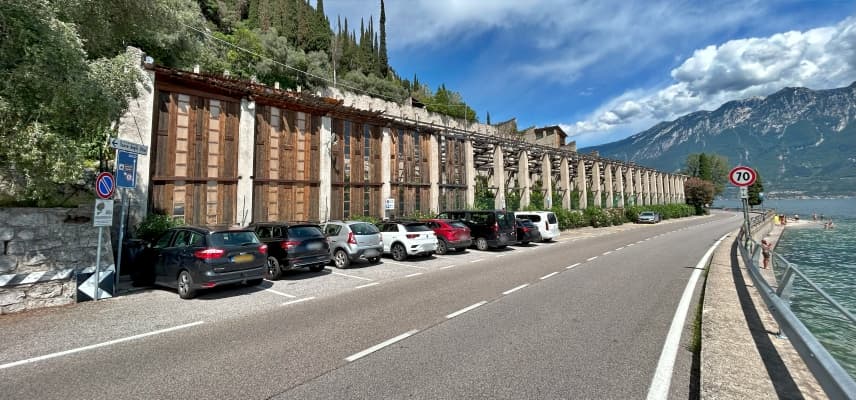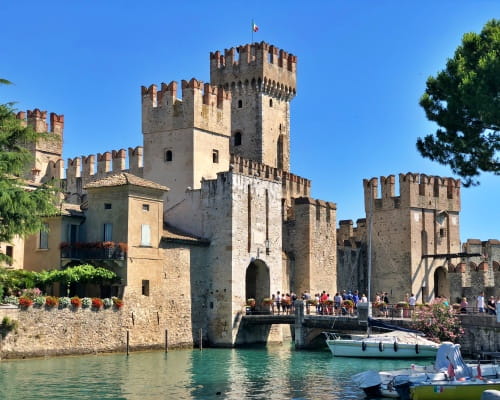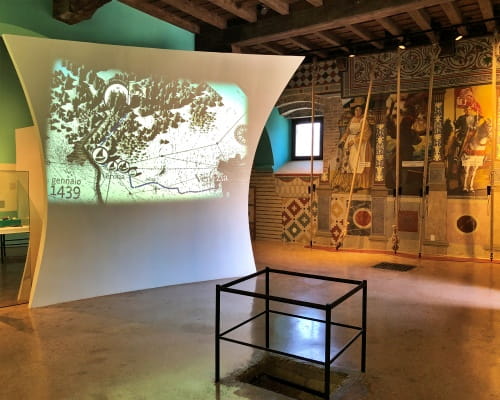The Ancient Lemon Houses of Lake Garda
From Limone sul Garda to Torri del Benaco, a four-stop journey to discover the oldest lemon houses of Lake Garda.
Thanks to its particular geographical position, Lake Garda provides a mild and temperate climate that favours the development of a rich and varied vegetation.
Among the typical cultivations, in addition to olives and vines, are lemons, which grow luxuriantly in this area in some beautiful lemon houses.
These ancient structures, built from the 14th century onwards, are the historical and architectural evidence of a particular agricultural tradition. The lemon houses are stone and wooden structures, equipped with glass windows and movable roofs, which protect the trees from the rigours of winter and allow the temperature and humidity to be regulated.
Lemons are fruits of Asian origin and were imported to Europe by some Arab populations. On Lake Garda they spread thanks to the intuition of the Franciscan monks of Gargnano, who were the first to start cultivating this plant.
Curious fact - The north-western shore of Lake Garda became famous as the northernmost place in the world for growing citrus fruits.
The lemon trade quickly changed the economy of this area of Lake Garda and many families devoted themselves to this profitable activity. Lemons were in great demand in northern European markets, mainly for two reasons: the presence of vitamin C, fundamental in fighting the widespread disease of scurvy, and citric acid, a well-known food disinfectant and preservative.
Today, some old lemon houses have been restored and turned into museums, where it is possible to discover the history and culture related to this cultivation.
In this article, we will talk about the main Garda lemon houses, we will see their main features and how to reach them, in a short tour divided into 4 stages.
First stage: Limonaia del Castèl
In the northernmost part of Lake Garda, and more precisely in the municipality of Limone sul Garda, is the Limonaia del Castèl, one of the best known and most visited lemon houses in the area.
Located in the historic centre of the town and only a few steps away from the harbour, it is optimally oriented to catch the beneficial rays of the sun and enjoys a spectacular view of the lake.
The Limonaia del Castèl was built in the early 18th century and over the years it changed owners several times, passing between the Amadei, Bertoni, Patuzzi, Girardi and Polidoro families. In 1926 it was purchased by Giuseppe Segala (1889-1975) and in 1995 became the property of the municipality of Limone sul Garda.
The Limonaia del Castèl is a stone and wood structure that is built on several levels and offers visitors a very suggestive guided tour.
The ground floor houses the ticket office, the bookshop and an exhibition room, where there are several information panels, period photographs and some objects related to the history of the lemon house.
The first floor is dedicated to the cultivation of citrus fruits, with around fifty plants of different varieties arranged in terracotta pots along the walls and windows.
The second floor is a multifunctional space, where exhibitions, meetings and educational workshops are held, with the aim of promoting local culture and art.
This lemon house, like other similar structures, is also equipped with a system of movable covers to protect the plants from the winter cold and to regulate temperature and humidity.
In the current lemon house, inaugurated on 22 July 2004, there are about a hundred plants including lemons, citrons, chinottos, sweet oranges, bitter oranges, mandarins, kumquats (Chinese mandarins) and grapefruits.
Second stage: Limonaia Pra dela Fam
Slightly further south, still along the western shore of Lake Garda, is the municipality of Tignale, where the Limonaia Pra dela Fam stands.
The curious name Pra dela Fam, corresponds to a dialect term that translated into Italian literally means "Prato della fame" (Meadow of Hunger). In past centuries, due to the strong headwinds that often blew in this part of the lake, fishermen were forced to stop here for a long time and sometimes without food.
Located at a side of the Gardesana road, a short distance from the port of Tignale, this beautiful structure faces south-east and enjoys an excellent panoramic view over Lake Garda.
The construction of the Pra dela Fam Lemon House dates back to the mid-1700s when the "old garden" was built, consisting of three terraces still in use and five terraces located further north, but currently in a state of neglect.
In the following years, various works followed to enlarge the lemon house, which remained operational at least until the period of the Unification of Italy. In the mid-1980s, the municipality of Tignale began renovating the lemon house and planted the several dozen trees that can be admired today.
Further maintenance work followed in 2007 and 2016, while in 2011 the Pra dela Fam lemon house became an integral part of the Ecomuseo delle limonaie del Garda.
During the summer, it is possible to visit the lemon house and discover through the rich information material inside, how the lemon plants were cultivated and what techniques were used to protect them from the cold.
At the Pra dela Fam Lemon House, it is also possible to buy numerous typical products such as limoncello, orange and lemon jams, lemon and orange citrus oil, multi-flower honey and the ever-present extra virgin olive oil.
Third stage: Limonaia La Malora
Travelling further south, more precisely in the territory of the municipality of Gargnano, it is possible to visit another splendid lemon house: La Malora.
Located close to the Gardesana road, a short distance from the historical centre of the town, the Limonaia La Malora is still active today and produces around 20,000 lemons each year.
Built around the 16th century, it owes its name to the rio Malora, a small stream flowing near the building, which in times past served to power the mill wheels.
After a long period of neglect, "La Malora" was purchased in 1978 by Giuseppe Gandossi, the current owner. Driven by his passion for the Gargnano area, Mr Gandossi skilfully renovated the lemon house, reconstructing parts of the stone walls and pillars, the windows, the planks and the irrigation system.
The lemon trees in "La Malora" belong to a variety typical of Lake Garda, known as "Madernina". These lemons have a medium size, a less thick peel and a distinct aromatic band. Unlike other lemons that come from warmer areas and are more sugary, these lemons are immediately recognisable by their more sour juice.
The tour of the Limonaia La Malora is divided into 13 zones, starting at the entrance to the building, passing through the three terraces and ending at the refreshment area.
It is precisely in the latter area of the lemon house that it is possible to taste and even buy, numerous typical food products. These include limoncino, limoncino verde, arancino, mandarin, various types of citrus jams, mostarde and syrups.
Fourth stage: Limonaia del Castello di Torri del Benaco
Closing the tour of ancient lemon houses is the Lemon House of the Castle of Torri del Benaco, located in the town of the same name on the eastern shore of Lake Garda.
This structure is also located in an ideal position to take advantage of the sun's rays, close to the Scaliger walls of the castle and just a few steps away from the harbour of Torri del Benaco.
The lemon house is an integral part of the tour inside the Museo del Castello Scaligero of Torri del Benaco, a must-see for lovers of history and culture. The castle was built in the 14th century by the Della Scala family, lords of Verona, to defend the nearby medieval village. The museum, set up in its rooms, exhibits archaeological finds, evidence of rural life and numerous pieces of fishing equipment. From the castle walls it is possible to enjoy a splendid panoramic view of the lake and surrounding mountains.
The construction of the lemon house dates back to the second half of the 18th century, a period in which the second castle wall was demolished and the moat buried.
The access to the lemon house is possible thanks to a small wooden bridge over a large water basin, which was once used to irrigate the lemon, orange, citron and mandarin trees. The latter received their water through some tufa channels and by means of perpendicular planks, which descended to the roots of the plants.
To reach the castle and visit its lemon house, we recommend you to use the ferry that connects the port of Maderno with the port of Torri del Benaco several times a day (we have talked about it in a specific article concerning Boats and Ferries on Lake Garda).
Our 4-stage tour to discover the ancient lemon houses of Lake Garda ends here. As always, we recommend you to visit these places and let yourself be enchanted by the magical atmosphere that is still present today.
For details about opening hours and ticket prices, please refer to the following links:
Image gallery
Click on the button below to open the image gallery.
How to get to the lemon houses
Click on the button below to open the detailed map.
What to see on Lake Garda
Many other sights await you, discover them below!






